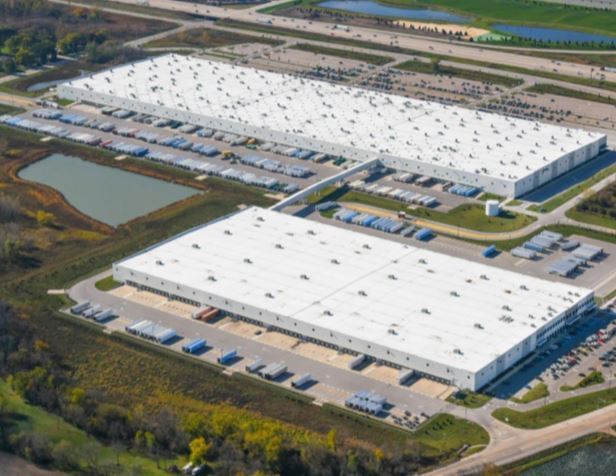 |
An aerial view of Amazon-leased logistics facilities in Kenosha, Wisconsin (Colliers International) |
South Korean institutional investors may see opportunities in the US commercial real estate market as industrial properties in the country garner traction amid the resumption of sales activities, an executive at Colliers International said Thursday.
While pointing out that major global blue-chip investors are increasingly tapping into top-tier warehouses in the US, Jeff Black, executive vice president of the company, said Koreans may have room to partner with them as long as they are willing to step into the debt-structured finance space.
Black brought up the latest credit facility negotiation between KKR & Co.’s warehouse-investing platform and Invesco’s affiliate, which would allow them to “take the best deals and move quickly to execute” when investing in industrial property assets.
“That could be a potential scenario where we can see Korean investors step in if they would be interested in potentially putting facilities like that together,” Black said in a webinar with Korean investors.
Black also cited data from the US Mortgage Bankers Association to show that industrial and logistics properties showed the lowest level of delinquency among all property asset classes. From January until July 20, 98.3 percent of loans to industrial assets were not delinquent.
“(Korean investors) can occupy a safer position in the capital stack, get a risk-adjusted alternative to equity ownership,” he said.
Along with debt-financing structures, Korean investors have room to jump into various US deals for logistics properties and data centers, including ones in Nevada and Arizona, as well as partnerships with US developers in a build-to-core strategy.
The sales activities of logistics centers and data centers are picking up pace since the first half of 2020, when uncertainty due to COVID-19 resulted in subdued transaction volumes.
The demand for e-commerce, last-mile distribution and onshoring is driving up demand for logistics centers in the US. At the same time, data centers are absorbing US companies’ rising demand for the migration of data to cloud systems. This spike in demand for warehouses and other industrial properties is outpacing supply, meaning top-tier targets are drying up.
The pricing of the industrial assets, however, remained firm as warehouses’ leasing activities remained healthy. Through the first half, industrial assets’ positive net absorption jumped over 6 percent on-year to nearly 10 million square meters, meaning demand outpaced supply for commercial properties from tenants like US distribution giant Amazon. This stood in contrast with US office properties’ negative net absorption at 1.3 million square meters during the second quarter, leading to an upshot in the vacancy rate.
Moreover, in the long run, the demand for distribution space will stay on a constant rise as more people at home buy products online. According to Colliers, COVID-19 has driven up to an estimated 280 million square meter of additional demand for industrial assets across the US.
Colliers’ estimate also indicated that data center sales transactions are expected to outnumber those in 2019 despite COVID-19. Single-asset sales of operational US data centers came to $1.2 billion this year until August, approaching $1.4 billion transactions throughout 2019. Portfolio sales this year saw $1.8 billion, with their yearly transactions at $3.3 billion in 2019.
By Son Ji-hyoung (
consnow@heraldcorp.com)






![[Herald Interview] 'Trump will use tariffs as first line of defense for American manufacturing'](http://res.heraldm.com/phpwas/restmb_idxmake.php?idx=644&simg=/content/image/2024/11/26/20241126050017_0.jpg)
![[Exclusive] Hyundai Mobis eyes closer ties with BYD](http://res.heraldm.com/phpwas/restmb_idxmake.php?idx=644&simg=/content/image/2024/11/25/20241125050044_0.jpg)
![[Herald Review] 'Gangnam B-Side' combines social realism with masterful suspense, performance](http://res.heraldm.com/phpwas/restmb_idxmake.php?idx=644&simg=/content/image/2024/11/25/20241125050072_0.jpg)